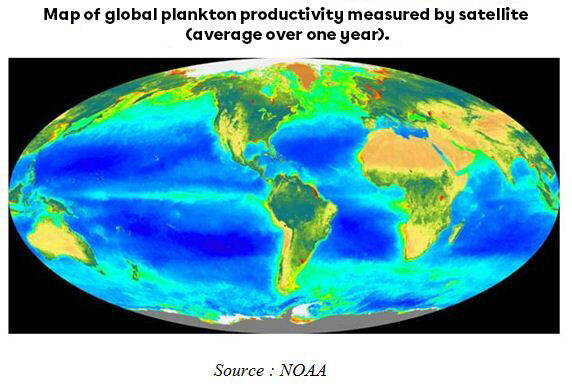-
Biomass is the total mass of all organic matter (plant and animal) present at a specific time in an ecosystem.
-
The primary productivity of an ecosystem is the quantity of new biomass obtained through the action of the producers in this ecosystem.
Primary productivity therefore represents the amount of energy available to primary consumers. The greater the primary productivity of an ecosystem, the more energy will be available. The ecosystem will then be able to support more living beings.
Several factors can affect the primary productivity of an ecosystem. The factors that will promote the development of producers (plants, phytoplankton, etc.) will make it possible to obtain a much more productive ecosystem, since primary productivity is directly dependent on them.
The amount of light is a factor that greatly influences primary productivity, as it is the radiant energy of the Sun that enables photosynthesis. In the ocean or in a lake, the illuminated area is not very large. The area where photosynthesis can take place is therefore a layer of water near the surface which is relatively thin, called the photic area (or euphotic area). This area corresponds to the depth at which the light reaches 1% of its value at the surface.
The amount of water available influences primary productivity. Water is necessary for photosynthesis. Thus, a desert ecosystem will be much less productive than a forest ecosystem. Since water is much scarcer in a desert, plants do not grow as easily.
Producers access to essential nutrients is another factor influencing the primary productivity in an ecosystem. Carbon, nitrogen, iron, phosphorus, silicon and potassium are necessary for the growth and photosynthesis of producers. The more these nutrients are available, the more the primary productivity is likely to expand.
Finally, temperature is a factor that promotes primary productivity, because certain climatic conditions are favourable to the growth of producers. Producers (plants) develop more easily in a forest ecosystem than in a polar ecosystem.
Distribution of plankton
The factors listed above cause plankton to be unevenly distributed in the oceans. On the map shown below, the green areas of the ocean correspond to the places where there is a high plankton productivity and conversely, the blue areas correspond to the places where there is a low plankton productivity.

Plankton is particularly abundant near the poles due to the abundance of mineral nutrients. These mineral nutrients are brought by continental leaching and by the upwelling of deep cold water. The deep cold waters also rise at the level of the Equator, bringing there a lot of nutrients, too. This is particularly true for the Pacific Ocean. Ocean circulation plays an important role in the distribution of plankton in the global ocean.